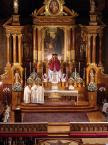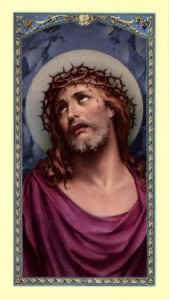
+JMJ+
Today is the feast day of this blog and the feast day for all families...Happy feast day everybody!!!
Vocation of the Family Is to Support Each Other on the Road to Heaven
In the Gospel we do not find speeches on the family but an event that is worth more than any word: God willed to be born and to grow up in a human family. In this way, He has consecrated the family as the first and ordinary way of His encounter with humanity.
During His life in Nazareth, Jesus honored the Virgin Mary and righteous Joseph, being subject to their authority during the whole time of His infancy and adolescence (Luke 2:51-52). In this way, He made evident the primary value of the family in the education of a person. Jesus was introduced to the religious community by Mary and Joseph, frequenting the synagogue of Nazareth.
With them He learned how to make the pilgrimage to Jerusalem, as narrated in the Gospel passage that the liturgy of the day proposes for our meditation. When He was 12 years old, He stayed behind in the temple, and His parents took three days to find Him. With that gesture, He led them to understand that He had to "attend to His Father's business," that is, to the mission that God had entrusted to Him (Luke 2:41-52).
This Gospel episode reveals the most authentic and profound vocation of the family: that of supporting each one of its members on the path of discovery of God and of the plan he has ordained for them. Mary and Joseph educated Jesus above all by their example: From his parents, he learned all the beauty of the faith, of the love of God and of his law, as well as the exigencies of justice, which finds its fulfillment in love (Romans 13:10).
From them He learned first of all that one must do God's will, and that the spiritual bond is worth more than that of blood. The Holy Family is truly the "prototype" of every Christian family that, united in the sacrament of marriage and nourished by the Word and the Eucharist, is called to carry out the marvelous vocation and mission of being a living cell not only of society but of the Church, sign and instrument of unity for the whole human race.
Let us now invoke together the protection of Mary Most Holy and of St. Joseph for every family, especially for those in difficulty. May they be supported so that they will be able to resist the disintegrating impulses of a certain contemporary culture which undermines the very basis of the family institution. May they may help Christian families throughout the world to be the living image of the love of God.
Benedict XVI, Feast of the Holy Family 2006
Things to Do:
Let us imitate the Holy Family in our Christian families, and our family will be a cell and a prefiguration of the heavenly family. Say a prayer dedicating your family to the Holy Family. Also pray for all families and for our country to uphold the sanctity of the marriage bond which is under attack.
Read more about Pope Leo XIII who instituted the Feast of the Holy Family and read his encyclical On Christian Marriage. You can also check out the Vatican's page of Papal documents on the Family.
Read the explanation of Jesus' knowledge in the activities section. Read Pope Pius X's Syllabus of Errors which condemns the modernist assertion that Christ did not always possess the consciousness of His Messianic dignity.
Have the whole family participate in cooking dinner. You might try a Lebanese meal. Some suggestions: stuffed grape leaves, stuffed cabbage rolls, lentils and rice, spinach and meat pies, chicken and dumplings, hummus, Lebanese bread, tabbouleh — a Lebanese salad and kibbi, a traditional Lebanese dish of specially ground meat mixed with spices and cracked wheat. This is the same kind of food that Mary served Jesus and St. Joseph. It's healthy and delicious.
Taken from www.catholicculture.org




































